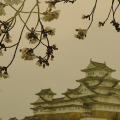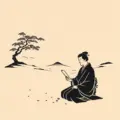A hokku is the starting verse of a renga or renku – forms of classical Japanese collaborative poetry. Hokku set the scene and seasonal context for the rest of the renga.
Later in the 19th century, the famous Japanese poet Masaoka Shiki (otherwise known as Masaoka Noboru) elevated the hokku to a standalone art form known as haiku. But traditionally, a hokku performed a different role.
Contents
What Role Does Hokku Play in Renga?
In renga, the first verse is known as the hokku. The hokku sets the scene and introduces the season or atmosphere. The hokku also provides a starting point for the poets to build upon.
For example, the hokku may contain a kigo or seasonal reference to autumn. The next poet then has to write a verse expanding on that autumnal theme.
So in renga, the hokku sets constraints and a direction for the rest of the collaborative poem while introducing the season, mood and setting.
What is the Structure and Form of Hokku?
Classically, hokku followed a very specific and rigid structure, much like haiku does today:
- Hokku consist of 17 onji (morae). An onji is a sound unit in Japanese poetry, similar to a syllable but defined more by duration of utterance. 17 onji allows the hokku to be brief yet impactful.
- Hokku are typically written in three lines of 5, 7 and 5 onji. This tercet structure creates an asymmetric rhythm that mimics natural speech patterns. The middle 7 onji line turns or shifts the poem, while the shorter outer lines provide bookends.
- Almost all classical hokku contain at least one kireji or “cutting word”. The kireji pauses the poem and often occurs after the 5th or 12th onji. It indicates a shift or surprise, cutting the verse into two parts.
- Hokku usually include at least one kigo or “season word” that indicates the season or time of year. Kigo create a context and atmosphere. For example, “spring rain” or “winter moon.”
This highly structured form served several key purposes in renga (linked poetry):
- It established a consistent length and pattern for the opening verse. This allowed the following renga poets to match their verses to the rhythm and tone.
- The self-contained nature of the hokku, with its kireji pause, helped set the hokku apart as the seed verse that inspired the rest of the renga.
- The seasonal kigo word helped create cohesion between the hokku and subsequent verses by providing a common setting or background.
The Difference Between Hokku and Haiku:
Haiku as we know it today descends from the hokku – the opening verse of renga. But over time, the connection between hokku and renga faded. Haiku became its own standalone art form no longer necessarily linked to collaborative poetry.
There are several key differences between hokku and modern haiku:
Hokku Must Precede Renga
A key aspect of hokku is their purpose – to precede and set the scene for a renga poem. So by definition, a standalone verse cannot be a hokku. Hokku are fundamentally linked to the collaborative form.
Hokku Introduce Season and Theme
Hokku introduce seasonal context and themes for the rest of the renga to expand upon. Modern haiku still often refer to nature or seasons, but not necessarily to provide context for subsequent verses.
Examples of Hokku
Here are some other famous examples of hokku starting off renga collaborations:
Matsuo Bashō’s hokku on autumn mist:
“Autumn mist –
white wisps hang
on scarlet leaves”
Yosa Buson’s summer hokku:
“Butterflies alight
on branches in the summer grove –
a shower passes”
Kobayashi Issa’s spring hokku:
“This world of dew
is only the world of dew –
and yet…oh, and yet…”
The seasonal images provide the atmosphere, mood and constraints for the renga to build upon verse by verse.
More Examples of Classical Hokku
Here are some other esteemed examples of early hokku opening renga collaborations:
Sōgi’s spring hokku:
“Spring has come –
spreading mist veils Mount Asaka
past the waking village”
Arakida’s summer hokku:
“The summer moor –
a soaring skylark sings
into the clouds”
Sōkan’s autumn hokku:
“Autumn wind – white chrysanthemum petals
scattered in the lane”
These verses demonstrate classical hokku’s atmosphere and seasonal allusions that subsequent poets expanded on in the following renga.
Famous Hokku Poets
While later haiku masters like Bashō developed the form, earlier poets helped establish hokku. These include:
- Sōgi (1421-1502) – an early pioneer of renga who helped develop hokku rules
- Moritake Arakida (1473–1549) – collaborated on influential renga while exploring hokku boundaries
- Yamazaki Sōkan (1465-1553) – a renga master who produced first hokku collection
Without these artists establishing the style, structure and seasonal context of hokku, the form may not have evolved into haiku centuries later.
Writing Hokku Today
Can authentic hokku exist today outside of the renga form? I’d argue the new hokku are impossible without the context of collaborative poetry. If you’re writing hokku without the extended form and collaborative nature of renga, then I’d say you’re more likely to be writing a haiku.
Personally, I think some of us, particularly poets in the early stages of their journey (if you’ll forgive the idiom) can easily get hung up on defining their poetry as one thing or another. I’d much rather write a great poem that doesn’t necessarily follow all the rules of haiku or hokku – even if I set out to write one – than a mediocre poem that does.
- Glossary of Japanese Poetry Terms - 26 February 2025
- What is Waka Poetry? - 23 May 2024
- How to Identify the Kigo in a Haiku: - 22 March 2024





